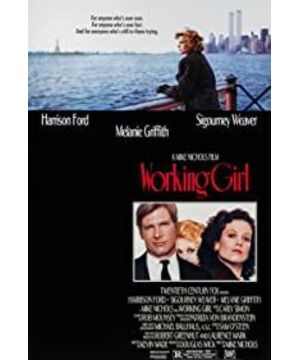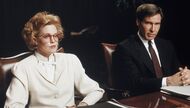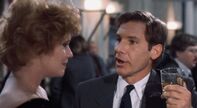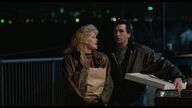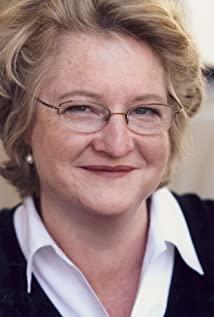"Working Girl" is a veritable "female film". The ancient and beautiful story of Cinderella in the famous fairy tale "Cinderella" has once awakened the dreams of many lower-class women in the world who have been sleeping for many years! They look forward to the day when they can put on a pair of golden shoes to get rid of their predicament, set foot on the upper class society they dream of, throw themselves into the arms of a prince charming, and live a carefree life from then on. In 1980, the American movie "From Nine to Five O'clock" starring Jane Fonda, Lily Tomlin and Dolly Button once concentratedly reflected this dream of American women. The economic take-off of the "Reagan era" in the mid to late 1980s further inspired American women's "Cinderella" dream. This film inherits certain traditions of American realism movies, with light-hearted brushwork and smooth and fast-changing comedy techniques, as well as beautiful pictures, life-like dialogues and beautiful music. Through the young girl Tess The legendary experience of an ordinary female secretary becoming a company manager tells the story of a modern "Cinderella" in American society. As a result, it has become a visual display of the "Cinderella Dream" of middle- and lower-class women in the United States, and has won the love of the majority of female audiences.
The protagonists of the film, except for the male agent Jack and Tess's boyfriend Mike, belong to two different levels of "working girls" who are struggling in the whirlpool of life. The struggle of the female secretary Tess was full of joy, anger, sorrow and joy. As a young and beautiful girl who is inexperienced in the world, she did not expect her boyfriend and her girlfriend to get involved; when Tess’s girlfriend Sean made a match between her and Mike and wanted them to reconcile. Both En and Mike ignored Tess's strong self-motivatedness, which made her feel more lonely and sadder. As an ideal female secretary, Tess not only wants to improve herself and get promoted through self-study, but also has to deal with the trivial affairs of the female secretary. For example, she not only has to be in the lower position in a male-dominated business world, but she also has to be conscientious in front of her female boss. Her male boss is pampered, her male colleagues mostly use her youthful beauty as a topic of pleasure, and she is sarcasm about her business shrewdness and sarcasm, and even scoffs at her evening school diploma. In addition to answering phone calls and typing documents one after another, she also has to be a "maid" for Catherine-preparing her tea and meals, dressing up, changing clothes and shoes, and even changing the toilet paper for her male boss! This may be a true portrayal of the fate of thousands of lower-class women in American society. Because of this, her struggle not only expressed the aspirations of working girls, but also became a model for lower-class women to follow suit.
Tess's girlfriend, Sean, had a curly shawl, slender and humorous. She and Tess get along day and night, they are in harmony, but they are not as self-motivated as Tess. Tess's boyfriend is looking for a new love, and Sean immediately mediates after learning about them, trying to reconcile their relationship. However, Sean did not understand that what Tess needed most was people's support for her enterprising spirit, and people's comfort for her when she was traumatized. The image of Sean reflects the numb psychology of a considerable number of American women who are content with the status quo and not enterprising.
Catherine's success as a woman in the business world depends not only on her existing social status, but also on her good use of her unique strength as a woman: sexy. Her dress is extraordinary, charming and coquettish, and a dress is worth six thousand dollars; she is scheming and scheming with her boss, and misses the opportunity to please the man. To a certain extent, Tess' later struggle experience also came at the expense of her own hue. Many places in the film show the nude scenes of Tess and Jack on the bed together, which become the footnote of the "golden shoes" of this modern Cinderella. In this sense, women have become a symbol of "sex" in this film. This excessive description of male and female romances and nude scenes not only reflects the deep-rooted influence of traditional Hollywood romantic films on creators, but also reduces the film's realism power.
The intricate relationship between the two women, Tess and Catherine, constitutes the main framework for the dramatic conflict in the film. Soon after the film's narrative began, these two "fair and fit ladies" with different positions became the targets of "gentlemen are good". However, they don't actually know each other's thoughts. After Catherine was injured, she entrusted Tess to her house to clean up the room. In order to imitate Catherine's voice, Tess repeatedly played Catherine's recorded phone messages, and accidentally discovered that Catherine had misappropriated her idea of developing business. Tess was shocked and wanted to find her boyfriend Mike for comfort. Unexpectedly, Mike shared the bed with his girlfriend Dolly. When Tess won the love of Catherine's boyfriend Jack, she was so excited that she described in her notebook the joyful scenes of their togetherness, their intention to cooperate, and the implementation plan and specific arrangements. Unfortunately, her record was seen by Catherine. Since then, the relationship between the two of them has begun to develop into a white-hot relationship.
Different from Cinderella's poor living environment, Tess lives in a modern social atmosphere that is diverse and compact. As described in "Wall Street", "New York, New York" and "The City That Never Sleeps" and other films set in Manhattan, New York, the story of "Working Girl" takes place in a skyscraper with a modern communication network. In the urban world. The film begins with a close-up of the Statue of Liberty in the foreground, and the camera shakes and pulls, not only showing the panoramic view of Manhattan in the New York metropolitan area, but also creating a dizzying and dazzling visual effect. This technique not only expresses the environment in which the film's story takes place, but also shows the American dream of freedom and prosperity as the main body, and also laid the foundation for the poetic and picturesque narrative style of the whole film.
Following the panoramic picture at the beginning of the film, the camera moves towards a ferry heading for Manhattan. After that, a group of high-view overhead shots showed that even in such a vast and boundless space, there are still countless individuals converging into a stream of people, crowded, rushing, flowing to one building, one staircase, one elevator after another. , A studio, start a day's work. In sharp contrast with the vastness of the open space that represented the dream of freedom and prosperity in the United States at the beginning of the film, the film has repeatedly shown the crowded streets, corridors, elevators, computer rooms and workshops, as well as the reception hall and board meeting room in the subsequent development. The combination of these scenes creates a screen image of a dizzying, fast-paced "business world". In this world, the weak eat the strong, and deceive others. The audience did not rejoice for the success of those merchants, on the contrary, they resonated strongly for the joys, sorrows and sorrows encountered by the lower class people represented by Tess to realize their dreams.
The narrative framework of this film is dramatic. The development of the story and the changes in the fate of the characters mainly depend on the dialogue of the characters, and the action is not strong. The scenes of the film are also mainly concentrated in indoor environments such as company buildings, offices, meeting rooms, corridors, elevators, bars and apartments. At least four factors have made the film successfully avoided stage and drama. One is that the film creators continuously interspersed scenes of streets, snow-capped mountains and bays, and Manhattan Island in these dialogue scenes, so that the narrative rhythm can be adjusted. Later, when Tess was sad because of setbacks at work, the empty shots shown in the opening of the film appeared in the film many times. For example, when Tess wanted to pour her heart out to her boyfriend and found out that he and his girlfriend had an affair, she angrily left her boyfriend's apartment and went to the beach alone, letting the cold sea breeze blow her hair. At this time, the camera crossed the dark blue bay under the vast night sky and hurriedly pushed out the brightly lit skyscrapers in the distance, setting off her loneliness and grief. Then, a ferry heading to Manhattan Island appeared on the screen, and then the camera opened, showing a close-up of Tess staring at the ferry from the office window in the foreground. She angrily dialed the phone of President Trasque. The use and combination of this group of shots cleverly show the transformation of space and the passage of time. The second is to use a variety of camera angles to show the different actions of the characters in the same space and the relationship between different characters. When Tess was transferred to serve as Catherine's secretary, Catherine verbally said that Tess was like her twin sister, but in fact she always regarded herself as her boss. A set of shots showed Catherine asked Tess to help her try on a pair of high-end sneakers. The scene repeatedly shows Tess, who was shot with the overhead lens, looking up at Catherine’s face, and the scene of Catherine, who was shot with the upside lens, looking down at Tess, plus Catherine’s arrogance and Tess’s obedient obedience and constant sweeping during their conversation. The shadow of Catherine who passed Tess's face vividly showed their master-servant relationship. The third is through the similarity and continuity of the actions, such as through Tess's purse and Jack's purse picking and their hugs and kisses, the shots of them in the corridor of the Trasque company building and the shots of them returning to Jack's apartment Join together. Another example is to create the illusion of three-dimensional space by repeatedly passing through the reflection of the image outside the elevator door and the mirror in the apartment. The fourth is the successful performances of film actors such as Mylanie Griffith, Harrison Ford and Siguene Weaver. The female secretary played by Griffith is vivid. The first thing she transferred to serve as Catherine's secretary was to be ordered to prepare coffee for her. Over time, as soon as she heard the word "coffee", she thought that making coffee for others was her unshirkable responsibility. Later, she and Jack went to a meeting hosted by the president. The secretary asked her if she wanted coffee. She stood up immediately as if reflexively, and wanted to take care of it herself. In the end, she became a manager herself, and the secretary wanted to bring her coffee. Her first reaction was to ask where the coffee pot was. Looking at the whole film, there are too many examples of such trivial details of life to show the character's psychology and personality. In addition, her voice is slender and slow, slightly hoarse, and a little feminine, successfully showing the screen image of a lowly female secretary.
The episode "Let the River Flow", which won the Academy Award for Best Film Music Theme Song, appeared many times in the film. At the beginning of the film, it was accompanied by scene shots showing the character environment, making the scenes from New York Bay to Manhattan Island, from the ferry to the Marshall Stock Brokerage Building, etc., smooth and poetic in one go. In several important moments of the turning point in Tess's destiny, the main theme of this music appears in the form of female humming and mixed accompaniment, and it merges with the picture that expresses Tess's efforts for the turning point of her own destiny. At the end of the film, the heroine Tess won everything she fought for: status, love and justice. When she dialed the phone of her girlfriend Sean, she only said one sentence: "Hi, Sean, it's me, Tess." Then she turned around. The next shot is a close-up of the back of Tess's head holding the phone; next, the lens rushes to show a close-up shot of Sean answering the phone. As Sean waved his hand to convey the good news to everyone, the theme song suddenly sounded. In the beautiful singing, the camera returned to Tess's office, and pulled away from the close-up shot of the new manager's hand-held phone, drawing a panoramic view of the company building. After an ingenious iteration, continue to zoom out, passing the spires of Times Square, showing a panoramic view of Manhattan Island's tall buildings. This method of treatment not only makes the beginning and the end anaphoric, but also integrates Tess's destiny and social environment into one. The meaning is far-reaching and memorable. With these techniques, the second half of the montage paragraph, without a single word of dialogue, pushes the mood of the film to a climax, causing the audience to smile with tears and sincere admiration.
View more about Working Girl reviews


